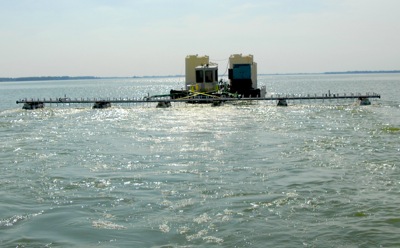Thursday, September 29th, 2011
Alum exceeds expectations
Treatment reduces some lake phosphorous levels by 56 percent
By Nancy Allen

Photo by Nancy Allen/The Daily Standard
Officials with HAB Aquatic Solutions, Lincoln, Neb., apply alum to Grand Lake on June 30. The state on Wednesday released a report showing the application succeeded in reducing phosphorous levels. Alum deactivates phosphorous, the main food source of the lake's toxic blue-green algae.
GRAND LAKE - A $3.4 million alum application in Grand Lake this summer was a success, the state said Wednesday.
Phosphorous levels were reduced 56 percent in the 4,900-acre treatment area in the center of the lake, according to a report by consultant Tetra Tech. Fifty percent reduction was the goal.
Alum deactivates phosphorous, the toxic blue-green algae's main food source. The report also showed phosphorous was reduced 20-30 percent in untreated areas.
"We're very pleased to report that it had the desired effect and exceeded the consultant's expectations," Scott Zody, interim director of the Ohio Department of Natural Resources, said.
Ohio EPA Director Scott Nally said it's "more than likely" the state will treat the lake with alum next year. State officials are researching funding and will make that decision in 30-45 days.
Local officials are happy with the results.
"There's been a very positive reaction by local folks, and they like the state's attention," said Tom Knapke, facilitator of the local Lake Restoration Commission (LRC). "Activities on the lake increased this summer and more people are coming to the region again."
The lake has suffered algae blooms that resulted in state-issued water quality advisories the last three years, decreasing lake visitation.
This year's application was funded with a $5 million Ohio EPA Water Pollution Control Loan that does not need repaid. Nally said the unused balance could help fund next year's application.
The state originally planned a $5 million application that included pretreating the water with hydrogen peroxide followed by a low dose of alum over the entire 13,500-acre lake. The project was pared to $3.4 million by hitting only the center of the lake with a higher dose of alum, after heavy rains in the spring loaded the lake with phosphorous.
Nally also said state-funded dredging and rough fish removal are helping the lake. Since early spring the state has removed 210,000 cubic yards of sediment from the lake's bottom and 13 tons of rough fish, which contribute to algae blooms.
Nally lauded the formation of the farmer-led Ag Solutions group, which is helping watershed farmers find solutions to manage their manure cost effectively. Farmland runoff, which contains high levels of phosphorous, has been blamed for some of the lake's problems.
About 68 percent of the 46,000 crop acres in the watershed is now covered under comprehensive nutrient management plans, Jim Zehringer, director of the Ohio Department of Agriculture, said.
A nutrient management plan outlines how to best apply manure to keep it from causing pollution. All lake watershed farmers eventually will be required to have a plan since the state labeled the watershed distressed. Previously, only state-permitted farms with a large number of livestock were required to have a plan.
Knapke said a forthcoming report from consultant Battelle Institute also will help formulate future plans to restore the lake. The LRC hired Battelle to review more than 50 products/actions recommended by various companies.
Nally said if the lake is treated next summer it would be done earlier before warmer weather spurs algae growth.
"We have to get out earlier than later due to temperature levels in March and April rather than June and July," he said.
State officials have said the groundbreaking data gathered from the Grand Lake alum treatment will help the state plan and execute future alum treatments on the lake and provide insight at other lakes and rivers.
Grand Lake was treated June 2-30 by HAB Aquatic Solutions, Lincoln, Neb. In all, 1.8 million gallons of aluminum sulfate (alum) and 900,000 gallons of sodium aluminate were applied. Sodium aluminate is a buffering agent that keeps pH levels even so fish aren't stressed and reduces possible damage to boat hulls.
It is the largest application of alum done in a body of water in the United States, HAB officials said.

